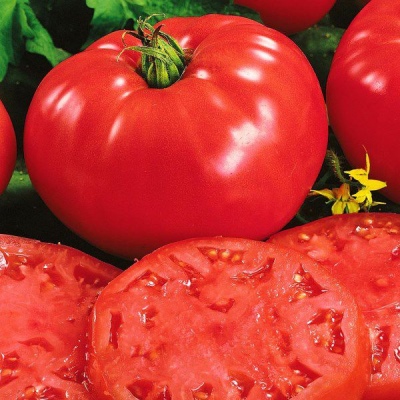
- Category: grade
- Growth type: determinant
- Appointment: universal
- Ripening period: mid-season
- Growing conditions: for open ground
- Bush size: medium-sized
- Bush height, cm: 70-80
- Ripe fruit color: deep red
- Fruit weight, g: 200
- Fruit taste: sweet
Large-fruited varieties of tomatoes have always been in special demand among summer residents. Lettuce tomato Sweet miracle is distinguished by good yield indicators, excellent delicious taste and persistent immunity to most tomato diseases. Easy care makes it possible to grow it even for a novice gardener.
Description of the variety
The culture is sprawling, determinant type, with an average height of 70-80 cm, which greatly simplifies its care, since it is not required to monitor its height. However, compulsory pinching is required. The foliage of this plant is green and medium in size. Tomatoes can grow up to 180 cm when grown in a greenhouse.
The main qualities of the fruit
Large fruits are formed on the bushes, flat-round, slightly ribbed, red in color. The pulp is fleshy and juicy, medium density. The weight of one reaches 200 g. With competent agricultural technology, the mass can be up to 500 g. Up to 3 tomatoes are formed on one brush.
Taste characteristics
The variety is very sweet, there is no sourness. The taste is balanced. Sugar pulp contains practically no liquid. This allows not only to use fresh fruits, but also to obtain aromatic juices and pastes from them. The sweetness of a tomato depends on the climatic conditions of the region. The more sun, the sweeter the taste. The sweet miracle is widely used in baby and diet food.
Ripening and fruiting
The plant is mid-season. Technical ripeness occurs at 110-115 days. Refers to mid-season varieties. Fruiting is long, starting in July and continuing until October. Ripening is gradual, the last ovaries are formed at the end of summer.
Yield
A sweet miracle - a high-yielding tomato. On average, up to 10 kg of fruit can be obtained from one bush. In the greenhouse, the amount of the crop increases several times. The harvested tomatoes are stored and transported without losing their flavor and do not flow. If you pick an unripe fruit, it will ripen quickly at room temperature.
The timing of planting seedlings and planting in the ground
Mid-season varieties require 60 days for seedlings to grow, so the date of planting seedlings is noted in advance. The best time is March or the first decade of April. If you plan to grow a crop in a greenhouse, then you can start germinating seeds as early as February.
Before starting sowing, the seeds must be disinfected and treated with a growth stimulating agent. It is preferable to use the soil already in the store. If this is not possible, then you can take an ordinary garden one, adding peat and sand, disinfect it with potassium permanganate. Seeds are spread at a distance of 2 centimeters from each other, and they are buried at the same distance. The container is covered with foil.
The room should be warm 20-23 degrees. After the emergence of seedlings, the temperature is reduced to +16. The temperature should be controlled, otherwise the seedlings will stretch out, which will create problems during planting. Saplings must be hardened. In April, the bushes are transplanted into a greenhouse, in June - into open ground.

Growing tomato seedlings is an extremely important process, because it largely depends on whether the gardener will be able to harvest at all.All aspects must be taken into account, from seedbed preparation to planting in the ground.
Landing scheme
When planting, you should adhere to the scheme 50 x 30 cm.When taking into account 3 plants per 1 square meter. It is not necessary to thicken the garden bed, as this reduces the amount of the crop.

Growing and care
The sweet miracle can grow beautifully both in the open field and in the greenhouse. By themselves, the bushes do not need a garter, but this event should not be neglected, since the fruits grow quite large and can simply break the stems. The formation of bushes in 2 stems and the timely removal of stepchildren will be mandatory.
Watering is moderate, several times a week. If the weather is hot, the irrigation is increased. To avoid excessive moisture loss, mulching is carried out from the soil. Loosening and removal of weeds should be carried out regularly. Seedlings are watered early in the morning, or in the evening at sunset. It is necessary to try to prevent moisture from getting on the foliage and stems, this can lead to the development of fungal infections.
To get a good harvest, you should take care of additional nutrition, which is carried out 2-3 times per season. It can be both organic and mineral fertilizers. Be careful with nitrogen. Its excess leads to excessive foliage and a small amount of inflorescence and fruit formation. In addition, nitrogen can accumulate in fruits in the form of nitrates.




A plant needs different micronutrients at each stage of growth. All fertilizers can be divided into two groups: mineral and organic. Folk remedies are often used: iodine, yeast, bird droppings, eggshells.
It is important to observe the rate and period of feeding. This also applies to folk remedies and organic fertilizers.
Disease and pest resistance
Tomato Sweet miracle firmly resists many diseases. But if it is incorrect to water or not to carry out molding and pinching, the air mode will break down in the bush, and a disease such as late blight may appear.
At the first signs of illness and a slight lesion of the area, you can treat with copper sulfate at a concentration of 2%. In case of extensive damage, diseased plants are removed in order to prevent infection of neighboring tomatoes.



























































































